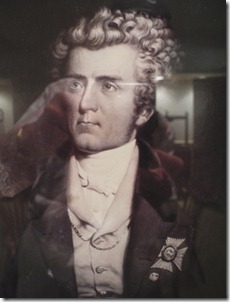The mood of Toronto became ominous in the autumn of 1837, with political opinions hardening on both sides – those who clamoured for reform against those who favoured the status quo. Discontent eventually exploded into open conflict, which once more thrust James Fitzgibbon on the central stage of Upper Canada. Fitzgibbon had been a hero during the War of I812. However, in some respects, the rebellion was to be more of a musical comedy than an opera. There was no fat lady, no chorus crooning in the background, nor big-bosomed women strutting past the scenery.
Fitzgibbon was fully aware of the situation. He was one of the few who was prepared to take action. He had experienced first-hand the explosive personality of the leader of the rebellion, William Lyon Mackenzie. Fitzgibbon warned the governor, Sir Francis Bond Head, whom the colonists often referred to as Bone Head, of the impending danger. Some of the Executive Council accused Fitzgibbon of being an alarmist and over-anxious to be embroiled in a conflict. Bond Head listened to his ill-informed advisors, and sent most of the troops to Lower Canada to help crush the rebellion in that province. Even in those days, the needs of Quebec took precedence in Canadian politics. However, as a precaution, Bond Head appointed Fitzgibbon as Adjutant-General of the Militia.
The evening following his appointment, Fitzgibbon sent a group of militiamen north of the city. They situated themselves behind a fence on Yonge Street, near where today Carlton Street is located. In the darkness, the troops under the command of Sheriff William Jarvis, confronted a band of rebels marching south to Toronto to join with other sympathizers. A few shots were fired, and in the ensuing confusion, both sides feared for their lives and fled. It is a pity that Maple Leaf Gardens had not been built. The combatants could have entered the arena and settled the fight with hockey sticks. In a civilized manner, they could have checked each other into the boards and cracked a few heads. Perhaps the Leafs of today might have inherited more of a fighting tradition if the battle had ended in this manner.
The next skirmish occurred on a cold December day. Fitzgibbon led the loyalist troops up Yonge Street to Montgomery’s Tavern, to disperse the rebels. The revolting farmers fled. Besides, the supply of beer had run out so there was no reason to stay. This effectively ended the Rebellion, and greatly enhanced Fitzgibbon’s reputation.
In 1838, Fitzgibbon served as Judge Advocate during the trials that followed the insurrection. Hanging usurpers by the neck (for more information Google “well-hung” heroes of Canada) was far more satisfying than shooting them. Hangings lasted longer, allowing a person sufficient time to knit while heads rolled (Google “Madame Defarge”). These events were the highlight of Fitzgibbon’s career. By the time the executions ended, he had completed two sweaters, five scarves, and ten pair of gloves. There was no “partridge in pear tree,” but there were many “Lords-a-leapin’” among the aristocracy, as they approved of hanging rebels who were disloyal to the crown.
In the years ahead, Fitzgibbon struggled to gain recognition, in the form of compensation, for his role in saving the colony of Upper Canada for the British Empire. His requests were ignored. He had won the battles, but lost the pension. He was never admitted to the famous old boys club, which remains in existence today——“The Pensions and Prostates Club.”
Meanwhile, the debts of his family increased each year. By 1843, the Bank of Upper Canada threatened court action to force him to repay his outstanding loans. Fortunately this was never done. Today, in America, the same legal action has been applied to the CEOs of failing banks.
Note: the above picture is of Sir Francis Bond
The above quote is from the book “The Villages Within,” which contains an irreverent account of the history of Toronto.
I have spent much of my adult life researching and photographing Toronto. I love the city and enjoy exploring it through my writing. One of the books, “The Villages Within”, was nominated for the Toronto Heritage Awards. If interested in novels with a Toronto setting, descriptions of the books are available by following the link: https://tayloronhistory.com/2012/03/22/toronto-author-publishes-seventh-novel/
They can be purchased in soft cover or electronic editions. All books are available at Chapters/Indigo and on Amazon.com. The electronic editions are less that $4. Follow the links:
There Never Was a Better Time: http://bookstore.iuniverse.com/Products/SKU-000056586/THERE-NEVER-WAS-A-BETTER-TIME.aspx
Arse Over Teakettle: http://bookstore.iuniverse.com/Products/SKU-000132634/Arse-Over-Teakettle.aspx
The Reluctant Virgin; http://bookstore.iuniverse.com/Products/SKU-000188306/The-Reluctant-Virgin.aspx
The Villages Within: http://bookstore.iuniverse.com/Products/SKU-000175211/The-Villages-Within.aspx
Author’s Home Page: https://tayloronhistory.com/
Authors can be contacted at: [email protected]
